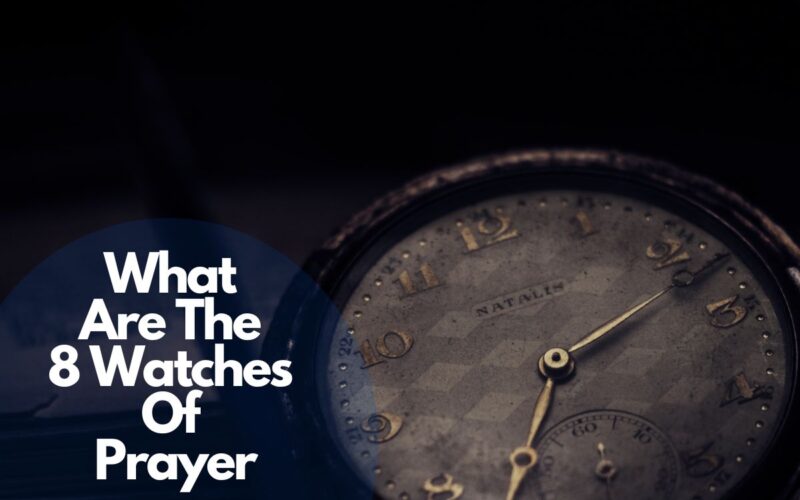Table of Contents Show
In the realm of spiritual observances, the concept of watches of prayer holds profound significance. Rooted in ancient traditions and followed by various religious communities, these watches symbolize devout moments of connection and reflection throughout the day and night. This article explores the essence of the eight watches of prayer, shedding light on their historical origins, contemporary relevance, and the diverse ways they are practiced across different cultures.
What Are the 8 Watches of Prayer
The watches of prayer, also known as canonical hours, refer to specific times of the day or night when devout individuals engage in prayer, meditation, or spiritual contemplation. These designated periods hold immense importance in numerous faith traditions, acting as pivotal points for spiritual communion and reflection.
Historical Origins: Tracing the Roots of the Watches of Prayer
The concept of watches of prayer traces its origins back to ancient monastic communities and religious orders. The practice gained prominence during the early centuries of Christianity, evolving from the Jewish tradition of reciting prayers at specific hours of the day. Over time, various Christian denominations and other religious faiths embraced this practice, incorporating their unique rituals and interpretations.
Significance in Different Religions: Exploring the Varied Perspectives
While watches of prayer hold a central place in Christianity, they are also observed in Islam, Judaism, and certain other religious traditions. Each faith interprets and practices these watches differently, infusing them with distinct spiritual meanings and rituals that reflect their respective beliefs and values.
The Eight Watches: Unveiling Each Watch and its Significance
First Watch: Dawn Prayer
The first watch, also known as the Dawn Prayer, marks the beginning of the day, serving as a sacred moment for spiritual awakening and setting intentions for the day ahead.
Second Watch: Morning Prayer
As the sun ascends higher, the second watch, the Morning Prayer, emphasizes gratitude, guidance, and seeking blessings for the tasks ahead.
Third Watch: Noon Prayer
The third watch, known as the Noon Prayer, invites individuals to pause amidst their daily endeavors, fostering a sense of mindfulness and gratitude for life’s bounties.
Fourth Watch: Afternoon Prayer
In the midst of the day’s hustle, the fourth watch, the Afternoon Prayer, encourages introspection and seeks solace in the midst of life’s challenges.
Fifth Watch: Evening Prayer
As daylight gradually fades, the fifth watch, the Evening Prayer, provides solace and reflection, enabling individuals to find peace and closure for the day’s events.
Sixth Watch: Sunset Prayer
With the setting sun, the sixth watch, the Sunset Prayer, signifies a moment of transition, urging individuals to seek balance and harmony within themselves and the world around them.
Seventh Watch: Early Night Prayer
The seventh watch, also known as the Early Night Prayer, encourages individuals to seek forgiveness, inner peace, and protection as the night unfolds.
Eighth Watch: Late Night Prayer
In the silence of the night, the eighth watch, the Late Night Prayer, invites contemplation, spiritual introspection, and seeking divine guidance before the dawn of a new day.
How to Practice Watches of Prayer: Rituals and Guidelines
Practicing watches of prayer involves adhering to specific rituals, recitations, and postures that vary depending on the religious tradition. Individuals often follow prescribed guidelines and texts while engaging in these spiritual observances, fostering a deeper connection with their faith and spirituality.
Benefits of Observing Watches of Prayer: Spiritual and Personal Growth
Engaging in prayer offers a multitude of benefits, including spiritual growth, inner peace, heightened mindfulness, and a stronger sense of connection with the divine. It fosters discipline and a sense of purpose, promoting a more balanced and fulfilling life.
Contemporary Relevance: The Role of Watches of Prayer in Modern Life
Despite the rapid pace of modern life, the practice of watches of prayer remains relevant, offering individuals a sanctuary of peace and reflection amidst the chaos of daily life. Many find solace in these sacred moments, fostering a sense of inner calm and spiritual fulfillment.
Global Practices: Comparing Observances Across Different Cultures
Across the globe, various cultures and communities practice watches of prayer, each infusing the observance with unique cultural elements and interpretations. A comparative analysis reveals the common threads that unite these diverse practices and the unique cultural nuances that distinguish them.
Misconceptions and Debunking Myths: Clarifying Misunderstandings
Amidst the cultural and religious diversity, there exist misconceptions and myths surrounding watches of prayer. It is essential to address and dispel these misconceptions, allowing for a deeper understanding and appreciation of the spiritual significance of these observances.
Impact on Daily Routine: Integrating Watches of Prayer in Daily Life
Integrating watches of prayer into one’s daily routine necessitates a balance between spiritual devotion and the demands of contemporary life. Adapting these practices to modern schedules and lifestyles ensures that individuals can reap the spiritual benefits without disrupting their daily responsibilities.
Personal Experiences: Insights from Individuals Practicing Watches of Prayer
Personal testimonies from individuals who regularly practice watches of prayer provide valuable insights into the transformative power of these spiritual observances. Their experiences offer a glimpse into the profound impact of these practices on their spiritual well-being and personal growth.
Challenges and Solutions: Overcoming Obstacles in Observing Watches of Prayer
While the observance of prayers can be deeply rewarding, it is not without its challenges. Identifying and addressing these challenges, such as time constraints or conflicting commitments, can help individuals overcome obstacles and maintain a consistent practice.
Enhancing Spiritual Awareness: Techniques for Deepening the Connection
To deepen their spiritual connection during watches of prayer, individuals can employ various techniques such as meditation, contemplative practices, and the study of sacred texts. These techniques aid in fostering a profound spiritual awareness and a deeper understanding of the divine.
Promoting Interfaith Dialogue: Fostering Understanding and Respect
The practice of watches of prayer offers a unique opportunity for interfaith dialogue and understanding. Encouraging respectful discussions and shared experiences among different faith communities can foster a sense of unity and mutual respect, promoting harmony and peace in society.
Emphasizing the Timeless Relevance of Watches of Prayer
In essence, the watches of prayer embody a timeless practice that transcends religious and cultural boundaries. Regardless of faith or tradition, the observance of these sacred moments fosters spiritual growth, inner peace, and a deeper connection with the divine, enriching the lives of individuals and communities alike.
Conclusion
In a world brimming with chaos and uncertainties, the 8 Watches of Prayer provide a sanctuary of spiritual solace and guidance.
Through their profound symbolism and historical significance, these watches serve as a constant reminder of the necessity for spiritual connection, inner reflection, and divine guidance. Embrace the journey through these sacred watches and unravel the spiritual abundance they offer.








